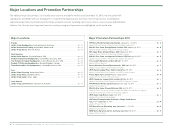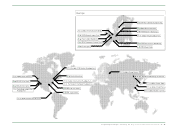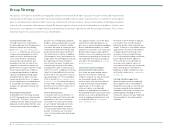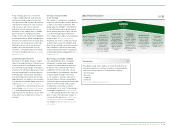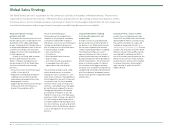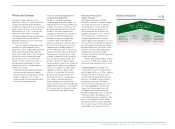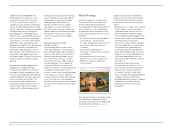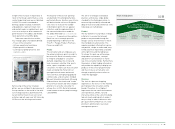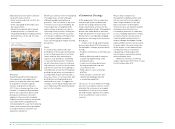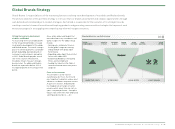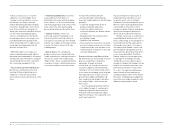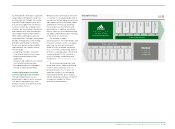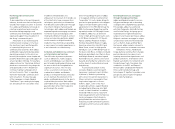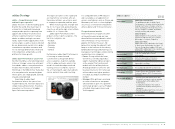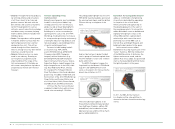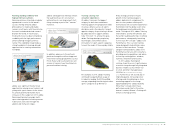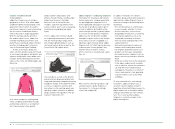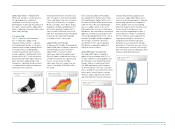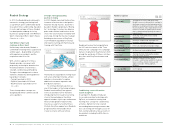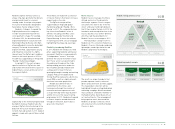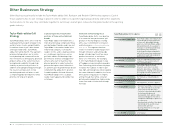Reebok 2010 Annual Report Download - page 92
Download and view the complete annual report
Please find page 92 of the 2010 Reebok annual report below. You can navigate through the pages in the report by either clicking on the pages listed below, or by using the keyword search tool below to find specific information within the annual report.
88 Group Management Report – Our Group Global Brands Strategy
To be successful across consumer
segments, we acknowledge that a
strategy of mass production or mass
marketing is no longer sufficient.
Only by identifying and understanding
consumers’ buying habits, their fitness
level, their motivations and goals for
doing sport and their individual lifestyle,
can we create meaningful products,
services and experiences that build a
lasting impression. In this respect, we
have identified five key global trends
which will be important to address with
our brands and sub-brands over the
duration of Route 2015:
– Fit for life: Sport is no longer just
about competing and winning. Sport is
becoming more embedded in consumers’
everyday lifestyles. Motivations and goals
are becoming more holistic, relating to
fun, socialising and quality of life.
– You are what you know and what you
do: Society is embracing a life-long
learning attitude, and placing more
emphasis on what we know and do
versus what we have and where we come
from.
– Celebrating individuality: Consumers
increasingly fulfil their desire to
differentiate from one another by being
more creative – on the one hand mixing
and matching products and services they
need, and on the other hand seeking
personalised offerings tailored for them.
– Together is better: There is an
increasing need for meaningful social
interaction, both online and offline, as
consumers are forced to be more mobile,
and the rise of digital technologies makes
it easier for them to connect with like-
minded people.
– Back to basics: For everyday life,
products and services are desired to be
simple and authentic, making consumers’
lives easier, rather than complicating
things further. There is a growing interest
in outdoor activities, reflecting the desire
to reconnect and be in tune with nature.
To match these trends and fulfil
consumer demands, Global Brands
teams will need to adhere to the following
principles:
– Create the unexpected in terms of
product and brand experience
– Create the highest emotional
connection between our brands and the
consumer
– Be prepared for the next generation,
anticipating change
– Simplify to the maximum
– Show excellence in execution, meaning
we have to make sure we are consistent
in whatever we do, from the idea to the
communication at the point of sale, and
in the worldwide web.
Brand architecture and differentiation
We believe that our multi-brand structure
gives us an important competitive
advantage. Through our brand
architecture, we seamlessly cover the
consumer segments we have defined,
catering to more consumer needs, while
at the same time keeping clarity of brand
message and values. In each case, the
positioning of adidas and Reebok and
their respective sub-brands is based on
their unique DNAs – their history and
their values.
As a true global brand with German
roots, adidas through its sub-brands is
targeting competitive sports based on
innovation and technology with adidas
Sport Performance. This sub-brand is the
multi-sport specialist.
Our positioning here clearly starts in
producing the best products for use
in specific sports such as football,
basketball, running and regional sports.
We then seek to leverage brand loyalty
and strength in innovation in other
categories. adidas Originals and adidas
Sport Style leverage the potential in
sports lifestyle and fashion markets.
Reebok, conversely, is an American-
inspired global brand and starts with
fitness and training as the backbone for
the brand’s positioning, especially for
active and casual sports. Consumers
who identify with Reebok’s values and
positioning will subsequently also be
attracted to the brand when they go for
a run, or play basketball. Therefore,
Reebok capitalises on the opportunity
to leverage its technology concepts
and designs also into specific sports
categories. Reebok thus bridges the two
ends of the consumer spectrum, from
performance athletes to style setters
see 02. Through these differences
in positioning, we are therefore not
cannibalising each other in the market,
but rather challenging and supporting
each other as friendly competitors with
different target groups in mind.


